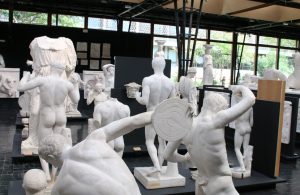 The Art of Plaster. Between Creation and Reproduction
The Art of Plaster. Between Creation and Reproduction
Faculty of Fine Arts, University of Lisboa / Calouste Gulbenkian Museum, Lisboa – Portugal, July 6 – 08, 2020
Deadline: Mar 10, 2020
The «Art» of Plaster – Between Creation and Reproduction – Study and Preservation
The «Art» of plaster has been valued by our historiography over the last few years. Indeed, it was at the end of the 20th century that the first in-depth studies on the application of plaster in architectural decoration began to emerge, and a new set of plastering artists became known and valued. However, issues concerning sculptural practice itself have been secondary until very recently, although the use of plaster as a material for artistic production has been a constant over the centuries. Because it is very easy to prepare and very malleable, it has been chosen as a material for both architectural decoration and sculpture, due to its ability to imitate other noble materials and, especially, because it is replicable if using casts.
In the artistic production field, even though they often do not represent the final work, the plaster pieces can show us the artists’ original intentions or the various studies and stages of artwork creation. Their preservation often represents the memory of the creation process itself.
On the other hand, its use for making moulds easily, and later plaster casts or reproductions, has allowed the spread of three-dimensional shapes around the world, making the great works of art available to those who could never see them in their original place. In the 19th-century Academies, it became practical to exchange patterns of the great museums and collections’ main sculptures, aiming at the creation of sets of models for students’ learning. At the same time, on the architectural decoration field, one witnesses a similar phenomenon, by finding elements copied from important national and foreign monuments.
The growing importance of teaching Industrial Art has also given great importance to learning through the observation and reproduction of the great national and international artistic models, seeking the creation of a new plastic expression, based on artistic tradition.
This teaching method is still common today, pursuing an ancient practice of learning for the future artists and our current students, through drawing, painting, sculpture or even copying, continue learning the basis for their future artistic development.
Although its presence in museums in the 19th century was not maintained in the following century, which gradually moved away from the idea of the Universal Museum, today, the reproductions of the great masterpieces are themselves valued objects, giving birth to large collections, which must be preserved and which have been occupying prominent places in numerous museums and art galleries in the international context.
The concern for the preservation of these elements is now a vital issue. The maintenance of plaster pieces is essential, as didactic material or as a register of the artistic creation, but also because they become unique testimonies of the state of the pieces in a certain moment, or even of the existence of some works of art that disappeared over the years.
The Conservation and Restoration field has also been developing studies dedicated to these issues, not only about the knowledge of production techniques and their evolution, but also about the type of restoration performed over time. To these aspects was added the importance of the information collected through the examination and analysis methods. With the wealth of information resulting from these studies, increasingly complete and elucidative information is gathered about the state of conservation of the plaster pieces and procedures to be followed for their preservation.
Thematic Lines
– Historical Memory / Art History
– Artistic Production
– Teaching
– Preservation, Conservation and Restoration
– Another subject
Official languages
Portuguese and English
Presentations
Those who are interested in participating must send an abstract of up to 400 words, including title, name, affiliation and text, along with a brief curriculum summary of 50 words maximum, to email aartedogesso@belasartes.ulisboa.pt by 10 March 2020.
The subject of the email, as well as the file, should have the following designation: ABSTRACT – Name of the first author.
Results will be released by 20 March 2020.

Leave a Reply
You must be logged in to post a comment.